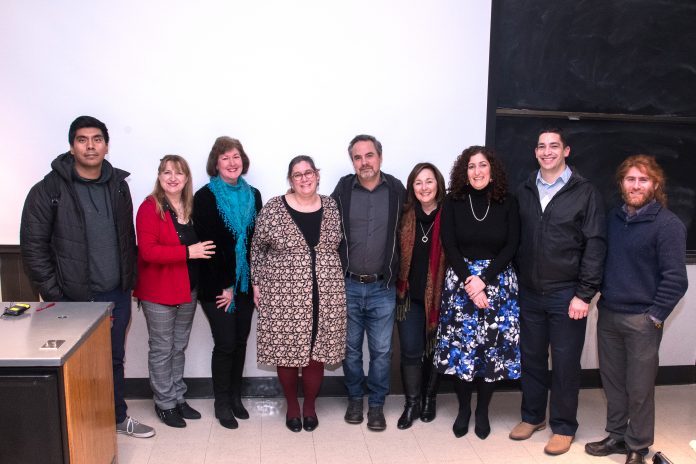
On Wednesday, Feb. 12 at 7 p.m., all appeared calm in Trumbower. Upon opening the door to room 130, the volume level of voices immediately betrayed how full the room was. People across the campus community had gathered to watch a screening of The Infiltrators by Alex Rivera. Rivera is a documentary filmmaker who has been focusing on the border between the United States and Mexico for around two decades. His work ties into the Center for Ethics’ theme, Borders, Nationalism, Identities: The Ethics of Global Citizenship.
For Rivera, this was a collaborative effort with Cristina Ibarra. For two years, they followed the National Immigrant Youth Alliance. This group is made up of young undocumented immigrants who had stopped their own deportations and work to organize and prevent other deportations from occurring. Rivera and Ibarra reached out to the group and built the film around their actions.
Some members of the alliance essentially turned themselves in to the United States Border Patrol and ended up being detained in the Broward County Detention Center in Fort Lauderdale, Fla. The issue was that Rivera had only filmed the outside portion of the tale. He and Ibarra had to figure out how to depict a place that cannot be seen, and so they settled on staging a reenactment of what had occurred in the detention center. This form of representation felt the most organic to the filmmakers, and they imitated the same ideas that were actually used at the time of the original infiltration. The real people involved talk, but actors portray some of the events described. A voice-over was added to set the scene and provide basic coverage for the viewers.
“The immigration crisis can seem so far removed for a lot of us, but this film brought it into the light. Getting to see the mistreatment of those who came to the U.S. for a better life is shocking and helps us understand our privilege and how important it is to fight for other humans.”
In 2012, Claudio Rojas was taken into custody by I.C.E and sent to Broward. An Argentinian, Rojas found himself surrounded by 600 other men of various backgrounds: Chinese, Haitian, Mexican and Salvadorian men were present, among others. Rojas’ son reached out to the Youth Alliance after doing some research on where to get help. One of the leaders on the outside, Mohammad, discussed the importance of what The Alliance does, including petitioning the government, which has the ability to stop deporting people. When the National Immigrant Youth Alliance takes a case, they create a profile on the person and start a petition. The purpose of the petitions are to annoy governmental and Congressional offices and provoke action.
“I don’t know why they want to send me to a place I do not know,” said Mohammad in the film. He immigrated to the United States with his parents at the age of three.
In order to rescue Rojas, another Alliance member, Marco, put his own safety on the line in order to infiltrate the detention center. In the process of building a case for Rojas, the Alliance managed to build cases for other detainees as well. One man, Ishmael, was a young student like Marco, while another man, Samuel, fled Honduras due to gang warfare and has an American wife and four children.
Marco discovered that the east wing of the center was the women’s wing, housing around 100 women. This led to Viri, another member of the Alliance, trying on two different occasions to infiltrate and gain access to the women. The woman Viri went in for was Maria, who was denied political asylum when she no longer felt safe in Venezuela. These are just a few of the people who were held for months or years without ever being charged for a real crime. Most couldn’t see their families and feared deportation at any moment. The small wins of getting individuals out are worth the big risks that are taken. The idea behind the infiltration was disruption of the system, and the motivation for doing this kind of work lies in the love for the community.
“I don’t know why they want to send me to a place I do not know.”
“I thought it was extremely incredible to see these young adults taking political action and putting their [lives] at risk to help the immigrants of the detention center,” said Renee Levine ‘22. “Also, it was extremely sad to hear the stories of the families that were separated because of the current laws regarding immigration.”
After the applause that accompanied the end of the film, Rivera led a short discussion. He stated how a specific f-word — freedom — needs to be used more in the immigration tale. He also said being without papers is not a crime. If it was a crime, those who lack them would be arrested by the local police, as opposed to a highly specialized department like I.C.E.
“The immigration crisis can seem so far removed for a lot of us, but this film brought it into the light. Getting to see the mistreatment of those who came to the U.S. for a better life is shocking and helps us understand our privilege and how important it is to fight for other humans,” reflected Michaela Hoenig ‘22.
“Who has a moral right to say you must stay there?” pondered Rivera. He stressed a responsibility to speak out in order to support those who cannot.





















